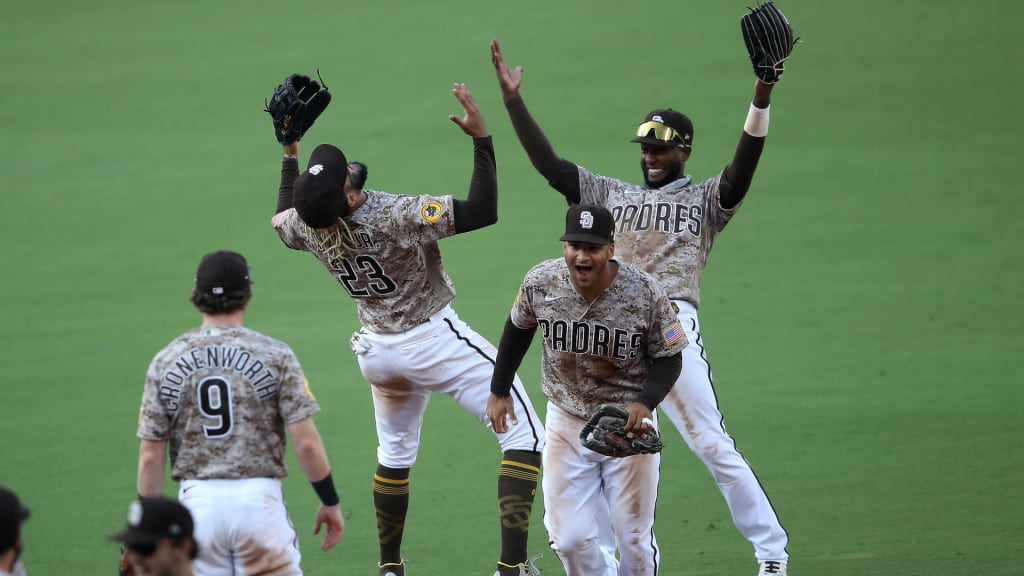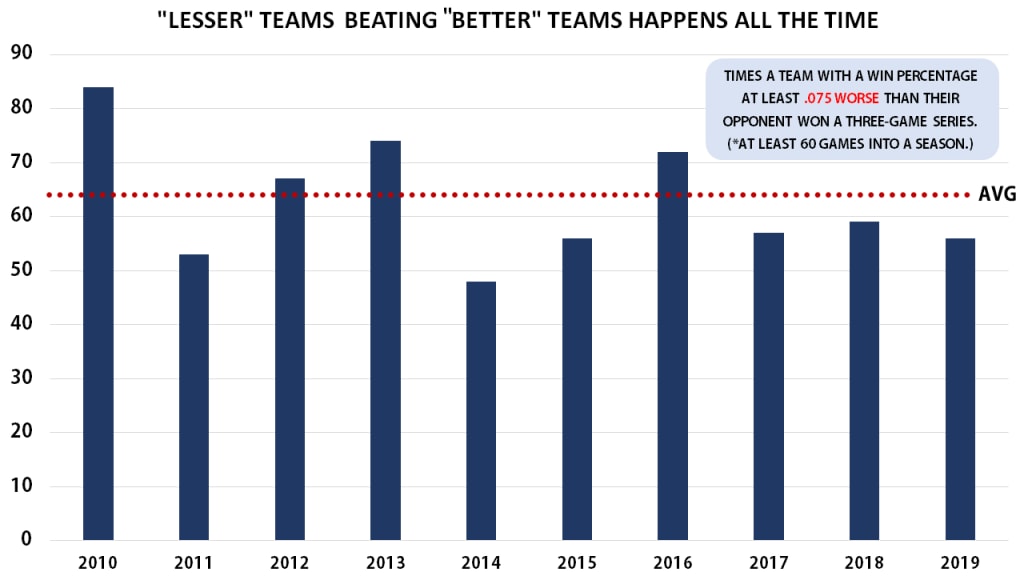
In the final days of June 2019, the 22-58 Orioles (.275) -- at the time the weakest team in baseball and well on their way to a 108-loss season -- welcomed Cleveland to Camden Yards. The Indians were 44-36 (.550), coming off three straight playoff appearances and would end up with 93 wins. As far as mismatches go, this was a particularly lopsided one.
On June 28, the Indians started Mike Clevinger, one of baseball's better pitchers. Baltimore won 13-0. On June 29, the Indians started Zach Plesac, who has quickly become one of baseball's better starters. Baltimore, again, won 13-0. That Cleveland won the third and final game of the series is irrelevant, at least for our purposes. In a best-of-three series -- like, say, the ones that comprise the upcoming Wild Card round of the expanded postseason -- the lowly Orioles would have earned the sweep in two games. They'd have advanced. Cleveland would have gone home having been outscored 26-0.
Would that be upsetting? Sure, probably. Would it tell you who the "better" team was? Not really. Most importantly, would it be surprising? Not in the absolute least. When a lower-ranked team defeats a higher-ranked team in a best-of-three next week, it won't be an upset. In a best-of-three series, at least in this sport, there's no such thing as an upset. Any outcome is reasonable.
You know that, probably, intuitively. In the course of a long season, the best team can lose two of three -- or all three -- to the worst team, and it's usually a speed bump, given that three games are something like 1.5% of a season. (Last year, the 106-win Dodgers dropped two September games to the 77-85 Giants, including one started by Clayton Kershaw. It was immediately forgotten.) It happens. A lot!
But we can do better. How often? It's important, because what might have been overlooked in July is going to mean the world in October. With the help of MLB.com's Tom Tango, we dug into the numbers.
What we did, to start, is to look back over the last decade of play, from 2010-19. We looked only at three-game series that began after each team had played at least 60 games entering the series, both to mirror 2020 but also to exclude things like early-April series where a 2-1 club played a 1-2 team.
Then, in order to not worry too much about an 82-80 team being "better" than an 81-79 team, we split it into two groups: one where one team's winning percentage at the time of the series was at least .075 better than their opponent, and one where the better team's winning percentage was at least .150 higher. (Yes, it's probably better to look at projections of talent rather than actual winning percentage, but let's be honest: That is not how people will be perceiving playoff matchups next week.)
(As of Monday morning, the postseason matchups are such that one matchup has a gap of over .200, four matchups have a gap of at least .100, and two more have a gap of at least .075.)
That seemed like a reasonable step, but it also didn't end up making that much of a difference. In each case, the better team won the series about two-thirds of the time.
From 2010-19, at least 60 games into the season, with a win% difference of at least .075:
The "better team" won 62% of the time.
From 2010-19, at least 60 games into the season, with a win% difference of at least .150:
The "better team" won 67% of the time.
That 5% gap isn't nothing, but it's not going to meaningfully change our story here, either. One out of three times, at least with a meaningful win percentage gap, the lesser team is likely to win. Right now, six of our eight projected playoff matchups would have a gap of at least .075. Guess what: At least one of those "better" teams is going to lose.
Going back over that decade, by year, you can see this happening dozens of times, just tucked into otherwise long seasons. If we look at the past few years, finding "upsets" where one team had a winning percentage advantage of at least .075 over the other -- and remember, this is just after 60 games for both teams, so we're only looking at about two-thirds of these seasons -- you can see how often this happens. Over the last decade, we see this about 60 times a season.

(If you're interested in the single biggest "upset" by this method, it came back in June 2013, when the .292 Marlins, on their way to losing 100 games, took two of three from the .652 Cardinals, who would go on to win the National League pennant. More recently, the eventual World Series-champion 2018 Red Sox took a .683 winning percentage into a June series against the .333 White Sox. They lost two of three, including a game in which Chris Sale struck out 10 and allowed just one run.)
For what it's worth, as we alluded to above, season-long win percentage isn't really the best way to look at what sort of teams and rosters you'll see in October anyway. When the Padres, for example, kick off their series (likely as the No. 4 seed, hosting the No. 5), they'll do so with a very different roster than the one that went 22-15 through the end of August. We pick that date because Aug. 31 was the Trade Deadline, which, as you might remember, involved San Diego general manager A.J. Preller trading 16 of his players and acquiring 10 new ones in return. Does it matter that the Padres were a few games over .500 in the first six weeks? Sure. Does it matter that half the season was played without Austin Nola, Clevinger, Mitch Moreland, Trevor Rosenthal and everyone else who's been swapped around? Sure does.
This is particularly notable for the Dodgers, the mostly unquestioned Best Team In Baseball, and one that has somehow made it through the season while losing just a single three-game series. (They dropped two of three to the Rockies in early September, which qualifies as a "slump" for this club.) Over the course of a season, no team can match the quality of their stars or the depth of their talent; this is why they're about to take their eighth consecutive National League West title. Over the course of a five- or seven-game series, against a good team, any combination of luck, timing or skill can lead to a loss. (Note that they've yet to turn any of those division titles into a World Series championship.)
Over a three-game series? It's reasonable to think that even the worst team in baseball could take two games from them; while the Rockies aren't quite that, they're not far off, either. If the postseason began today, the Dodgers would face the Reds, a "mere .500 team," one with a massive .204-point difference in winning percentage. Over the last 10 seasons, at least during the point in the year when each club had played 60 games, we've seen 51 times where a team at least 200 points inferior to their opponent won in a head-to-head three-game series. This happens a few times every season.
The 2020 Reds are not the 2020 Dodgers. And yet: We're assuming that most of those "disadvantaged by 200 points" teams couldn't throw Trevor Bauer, Luis Castillo and Sonny Gray as their top three starters. (They're also on a winning streak, taking seven of eight entering Monday, though "being hot" entering the playoffs being a differentiator is a myth that's been roundly discarded. Either way, it's not like the Dodgers are struggling.) The winning percentage gap might be large, but the talent gap is much slimmer.
If the mighty Dodgers, or any good team, were to drop the Wild Card Series to the Reds, or any seemingly lesser team, it might be a disappointment, depending on your point of view. It might even be a surprise. But it won't be an upset, or proof that some team wasn't "constructed for October." It's nearly a guarantee that a higher seed will lose. After all, three games are not enough to tell us which team is "better." (162 games might not be enough!) After all, worse teams beat better teams in short seasons all the time. This one will just be a bit more notable.
